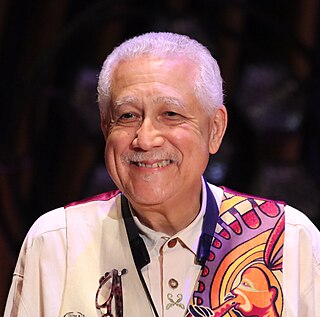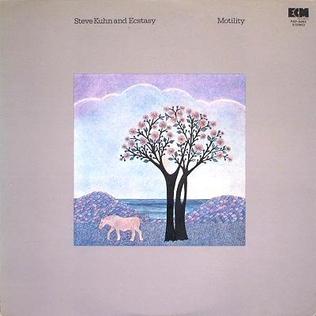| On the Other Hand | ||||
|---|---|---|---|---|
 | ||||
| Studio album by | ||||
| Released | 1990 | |||
| Genre | Latin jazz | |||
| Label | Epic | |||
| Producer | Michel Camilo | |||
| Michel Camilo chronology | ||||
| ||||
On the Other Hand is an album by the Dominican musician Michel Camilo, released in 1990 by Epic Records. [1] [2]
| On the Other Hand | ||||
|---|---|---|---|---|
 | ||||
| Studio album by | ||||
| Released | 1990 | |||
| Genre | Latin jazz | |||
| Label | Epic | |||
| Producer | Michel Camilo | |||
| Michel Camilo chronology | ||||
| ||||
On the Other Hand is an album by the Dominican musician Michel Camilo, released in 1990 by Epic Records. [1] [2]
| Review scores | |
|---|---|
| Source | Rating |
| AllMusic | |
| Select | |
Newsday wrote that Camilo's "classical-jazz-Latin synthesis is one of the more avant-garde statements by a contemporary pianist... Rather than simply pumping up jazz tunes with Latin rhythmic structures, he speaks in several musical languages at once, prefiguring a multicultural future." [5] The Globe and Mail noted that "as impressive a pianist as Camilo clearly is, he startles not by what he plays, but by how: chop, chop, chop—quick, clean and on the flashy side of frantic." [6]
| No. | Title | Writer(s) | Length |
|---|---|---|---|
| 1. | "On the Other Hand" | Camilo | 4:05 |
| 2. | "City of the Angels" | Pastorius | 4:25 |
| 3. | "Journey" | Camilo | 5:46 |
| 4. | "Impressions" | Coltrane | 5:45 |
| 5. | "Silent Talk I" | Camilo | 3:42 |
| 6. | "Forbidden Fruit" | Camilo, Eigenburg | 4:23 |
| 7. | "Suite Sandrine, Pt. 3" | Camilo | 8:46 |
| 8. | "Birk's Works" | Gillespie | 5:49 |
| 9. | "Silent Talk II" | Camilo | 4:37 |

Rhapsody in Blue is a 1924 musical composition written by George Gershwin for solo piano and jazz band, which combines elements of classical music with jazz-influenced effects. Commissioned by bandleader Paul Whiteman, the work premiered in a concert titled "An Experiment in Modern Music" on February 12, 1924, in Aeolian Hall, New York City. Whiteman's band performed the rhapsody with Gershwin playing the piano. Whiteman's arranger Ferde Grofé orchestrated the rhapsody several times including the 1924 original scoring, the 1926 pit orchestra scoring, and the 1942 symphonic scoring.

Horace Ward Martin Tavares Silver was an American jazz pianist, composer, and arranger, particularly in the hard bop style that he helped pioneer in the 1950s.

Henry "Hank" Mobley was an American tenor saxophonist and composer. Mobley was described by Leonard Feather as the "middleweight champion of the tenor saxophone", a metaphor used to describe his tone, that was neither as aggressive as John Coltrane nor as mellow as Lester Young, and his style that was laid-back, subtle and melodic, especially in contrast with players such as Coltrane and Sonny Rollins. The critic Stacia Proefrock claimed him "one of the most underrated musicians of the bop era." Mobley's compositions include "Double Exposure", "Soul Station", and "Dig Dis".

Michel Petrucciani was a French jazz pianist. From birth he had osteogenesis imperfecta, a genetic disease that causes brittle bones and, in his case, short stature. He became one of the most accomplished jazz pianists of his generation despite his health condition and relatively short life.

Michel Camilo is a Dominican pianist and composer. He specializes in jazz, Latin and classical piano work.
Edwin James Costa was an American jazz pianist, vibraphonist, composer and arranger. In 1957, he was chosen as DownBeat jazz critics' new star on piano and vibes – the first time that one artist won two categories in the same year. He became known for his percussive, driving piano style that concentrated on the lower octaves of the keyboard.

Francisco de Jesús Rivera Figueras, known as Paquito D'Rivera, is a Cuban-American alto saxophonist, clarinetist and composer. He was a member of the Cuban songo band Irakere and, since the 1980s, he has established himself as a bandleader in the United States. His smooth saxophone tone and his frequent combination of Latin jazz and classical music have become his trademarks.

Joseph Leslie Sample was an American jazz, Jazz fusion keyboardist and composer. He was one of the founding members of The Jazz Crusaders in 1960, the band which shortened its name to "The Crusaders" in 1971. He remained a part of the group until its final album in 1991 and also the 2003 reunion album Rural Renewal.
"Oye Cómo Va" is a 1962 cha-cha-chá by Tito Puente, originally released on El Rey Bravo. The song achieved worldwide popularity in 1970, when it was recorded by American rock group Santana for their album Abraxas. This version was released as a single in 1971, reaching number 13 on the Billboard Hot 100, number 11 on the Billboard Easy Listening survey, and number 32 on the R&B chart. The block chord ostinato pattern that repeats throughout the song was most likely borrowed by Puente from Cachao's 1957 mambo "Chanchullo", which was recorded by Puente in 1959.

Franck Amsallem is a French-American jazz pianist, arranger, composer, singer and educator. He was born in 1961 in Oran, French Algeria, but grew up in Nice, France.
Horacio "El Negro" Hernández is a Cuban drummer and percussionist. He has played alongside Latin jazz pianists such as Gonzalo Rubalcaba, Michel Camilo, Chucho Valdés, Eddie Palmieri and Hilario Durán.

Why not? is an album by Michel Camilo, released in 1985.

On Fire is a studio album of Latin jazz music, mostly by the Dominican composer Michel Camilo. It was released in 1989.

One More Once is a 1994 album by the Latin jazz pianist Michel Camilo.
Michael Philip Mossman is an American jazz trumpeter.
Ralph Bowen is a Canadian jazz saxophonist.

Live at the Blue Note is an album released by Michel Camilo on August 26, 2003. It was recorded at the Blue Note club in New York City in March 2003. Camilo, with Charles Flores, Horacio "El Negro" Hernández and Robert Friedrich, were awarded the Grammy Award for Best Latin Jazz Album for this release.

Motility is an album by American jazz pianist Steve Kuhn, recorded for ECM in January 1977 and released in April later that year, Kuhn's second album with his Ecstasy quartet, featuring saxophonist Steve Slagle and rhythm section Harvie Swartz and Michael Smith.

Solo is a piano album by Michel Camilo. It was recorded in 2004 and released by Telarc in 2005.

What's Up? is a solo piano album by Michel Camilo. It was recorded in 2013 and released later that year by Okeh Records.